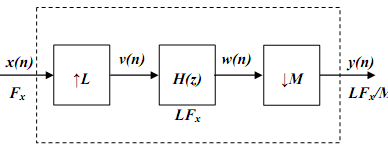This set of Digital Signal Processing Multiple Choice Questions & Answers (MCQs) focuses on “Multirate Digital Signal Processing”.
1. There is no requirement to process the various signals at different rates commensurate with the corresponding bandwidths of the signals.
a) True
b) False
View Answer
Explanation: In telecommunication systems that transmit and receive different types of signals, there is a requirement to process the various signals at different rates commensurate with the corresponding bandwidths of the signals.
2. What is the process of converting a signal from a given rate to a different rate?
a) Sampling
b) Normalizing
c) Sampling rate conversion
d) None of the mentioned
View Answer
Explanation: The process of converting a signal from a given rate to a different rate is known as sampling rate conversion.
3. The systems that employ multiple sampling rates are called multi-rate DSP systems.
a) True
b) False
View Answer
Explanation: Systems that employ multiple sampling rates in the processing of digital signals are called multi rate digital signal processing systems.
4. Which of the following methods are used in sampling rate conversion of a digital signal?
a) D/A convertor and A/D convertor
b) Performing entirely in digital domain
c) None of the mentioned
d) D/A convertor, A/D convertor & Performing entirely in digital domain
View Answer
Explanation: Sampling rate conversion of a digital signal can be accomplished in one of the two general methods. One method is to pass the signal through D/A converter, filter it if necessary, and then to resample the resulting analog signal at the desired rate. The second method is to perform the sampling rate conversion entirely in the digital domain.
5. Which of the following is the advantage of sampling rate conversion by converting the signal into analog signal?
a) Less signal distortion
b) Quantization effects
c) New sampling rate can be arbitrarily selected
d) None of the mentioned
View Answer
Explanation: One apparent advantage of the given method is that the new sampling rate can be arbitrarily selected and need not have any special relationship with the old sampling rate.
6. Which of the following is the disadvantage of sampling rate conversion by converting the signal into analog signal?
a) Signal distortion
b) Quantization effects
c) New sampling rate can be arbitrarily selected
d) Signal distortion & Quantization effects
View Answer
Explanation: The major disadvantage by the given type of conversion is the signal distortion introduced by the D/A converter in the signal reconstruction and by the quantization effects in the A/D conversion.
7. In which of the following, sampling rate conversion are used?
a) Narrow band filters
b) Digital filter banks
c) Quadrature mirror filters
d) All of the mentioned
View Answer
Explanation: There are several applications of sampling rate conversion in multi rate digital signal processing systems, which include the implementation of narrow band filters, quadrature mirror filters and digital filter banks.
8. Which of the following use quadrature mirror filters?
a) Sub band coding
b) Trans-multiplexer
c) Sub band coding & Trans-multiplexer
d) None of the mentioned
View Answer
Explanation: There are many applications where quadrature mirror filters can be used. Some of these applications are sub-band coding, trans-multiplexers and many other applications.
9. The sampling rate conversion can be as shown in the figure below.

a) True
b) False
View Answer
Explanation: The process of sampling rate conversion in the digital domain can be viewed as a linear filtering operation as illustrated in the given figure.
10. If Fx and Fy are the sampling rates of the input and output signals respectively, then what is the value of Fy/Fx?
a) D/I
b) I/D
c) I.D
d) None of the mentioned
View Answer
Explanation: The input signal x(n) is characterized by the sampling rate Fx and he output signal y(m) is characterized by the sampling rate Fy, then
Fy/Fx = I/D
where I and D are relatively prime integers.
11. What is the process of reducing the sampling rate by a factor D?
a) Sampling rate conversion
b) Interpolation
c) Decimation
d) None of the mentioned
View Answer
Explanation: The process of reducing the sampling rate by a factor D, i.e., down-sampling by D is called as decimation.
12. What is the process of increasing the sampling rate by a factor I?
a) Sampling rate conversion
b) Interpolation
c) Decimation
d) None of the mentioned
View Answer
Explanation: The process of increasing the sampling rate by an integer factor I, i.e., up-sampling by I is called as interpolation.
Sanfoundry Global Education & Learning Series – Digital Signal Processing.
To practice all areas of Digital Signal Processing, here is complete set of 1000+ Multiple Choice Questions and Answers.
If you find a mistake in question / option / answer, kindly take a screenshot and email to [email protected]
